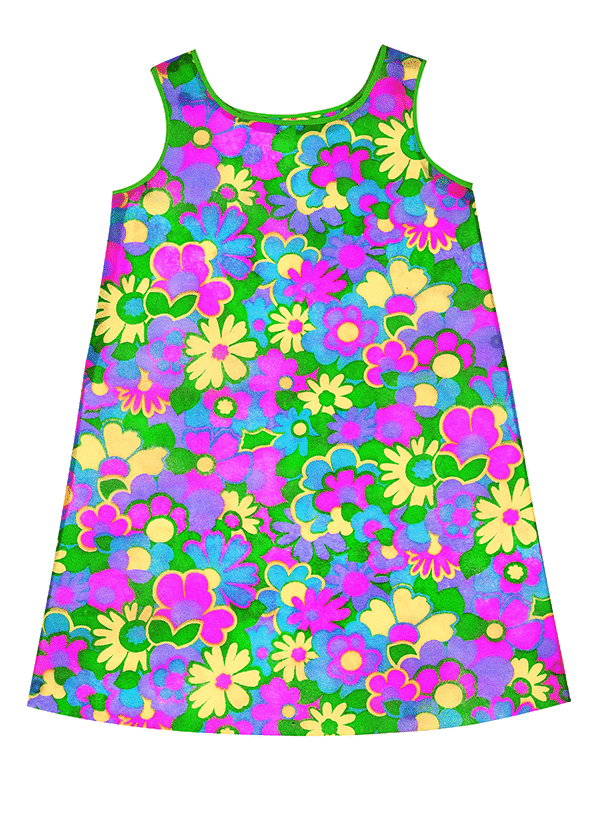2005 - 2022
RRRIPP!! Collection
- 60′s disposable American Paper Dresses (selected pieces)
- Ethnological collection (selected pieces)
In 2005, ATOPOS cvc started collecting paper garments for research purposes and for experimenting with new exhibition concepts in an object-inspired manner. The research focused on the 1960s popular, but short-lived, American fad of disposable paper dresses. Destined to be worn once and then thrown away, these mass-produced paper dresses represent the main core of the RRRIPP!! Collection.
HISTORY
Disposable paper dresses first appeared in the USA in 1966 when they were produced by the Scott Paper Company to promote its products. The paper dresses were addressed to a consumer public that was already using disposable cups, plates, napkins and tablecloths and many other everyday objects. The unexpected success achieved by the first samples of these dresses led to the creation of ‘paper fashion’, which inundated the US market for almost two years (1966-1968).
MATERIALS
Fun, modern and liberating, these paper garments were made in the spirit of their times, where experimentation in new industrial materials based on plastic or metal was applied to everyday life and fashion. The new, non-woven materials used to manufacture the dresses, gave the impression of paper, even though, apart from cellulose, their components included cotton, rayon, polyester and new-technology synthetic fibres.
DESIGNS
The designs and images used on the paper dresses were taken from visual stimulants of the time, thus contributing to their popularity. Op art, newspapers, Pop and psychedelic patterns, retro Art Nouveau designs, trademark logos and even the faces of the 1968 election candidates were used to adorn the dresses, thus creating an exciting and imaginative canvas of multi-coloured motifs.
DECLINE
After 1968 ‘paper fashion’ went into decline because of its overexposure and the fact that the public was turning its concerns toward ecology and a ‘return to nature’ – a new trend that did not hold disposable products in high esteem. Since its decline, however, the paper fashion fad of the late ‘60s has inspired contemporary fashion designers in experimenting with paper garments and recycling techniques.
CONTEMPORARY PIECES IN THE COLLECTION
Apart from the main core of the 1960’s paper dresses, the ATOPOS cvc RRRIPP!! Collection includes key pieces from the following fashion designers: Issey Miyake, Helmut Lang, Maison Martin Margiela, Walter Van Beirendonck, Dirk Van Saene, Hugo Boss, and Hussein Chalayan among others. This new found interest in paper clothing also inspired ATOPOS cvc to create the RIPPING ATOPOS project, in which contemporary artists and fashion designers are commissioned to create their own works of art, inspired by specific pieces or the whole of the collection. Artists and designers such as Robert Wilson, Howard Hodgkin, Demna Gvasalia, Jannis Varelas, Michael Cepress, Bas Kosters, Travis Hutchison, Angelo Plessas and Maurizio Galante,Angelos Frentzos,Yiorgos Eleftheriades, Angelos Bratis, Irini Miga, Zoe Keramea, either created new works of art or have transformed and revisited original items from the collection in the spirit of creative re-cycling.
THE ISSEY MIYAKE PLEATS PAPER DRESS DONATION, 2008
Issey Miyake designed nine work-in-progress pieces made from paper for the exhibition “XXIst Century Man”, held at 21_21 Design Sight in Tokyo. With regard to textiles he believes that in about fifty years time paper will be the only fibre still available. So Miyake and his team spent months exploring various types of paper and processing techniques. The clothes that have been donated to the RRRIPP!! Collection are the results of the many experiments conducted during the design process. They are made from industrial packaging paper and, like the textiles in the “Pleats Please” collection, the paper was pleated and handcrafted. Consequently, he donated these nine original and unique pieces to ATOPOS cvc, requesting only that they always be displayed as part of the collection.
ETHNOLOGICAL PIECES IN THE COLLECTION
During the course of its research ATOPOS cvc also acquired some rare examples of paper clothing and accessories from earlier historical periods and non-Western cultures, such as Japan and China. Most notably, the collection includes garments and accessories made in the Japanese manner of kamiko and shifu. The kamiko process has been known since the 10th century, where strong sheets of paper are softened and then starched with vegetable juice to produce a durable material. Paper weaving, or shifu, was developed in 16th-century Japan; in this technique, strips of paper are twisted into threads and are then woven. These rare pieces and other historic items of the RRRIPP!! Collection serve not only as examples of the use of paper in the manufacture of clothing, but also as a surprise and a delight for the viewer.
RRRIPP!! Exhibition
Providing a comprehensive representation of paper clothing in the history of dress and design and numbering today more than five hundred items, the RRRIPP!! Collection forms the basis of the RRRIPP!! Paper Fashion exhibition, which ATOPOS cvc showed for the first time in Athens in 2007 (Benaki Museum). The success of the show enabled ATOPOS cvc to collaborate with European Museums on new interpretations of the exhibition, first in Luxembourg (Musée d’ Art Moderne Grand-Duc Jean / MUDAM, 2008), then in Antwerp (Mode Museum / MoMu, 2009), Bologna (Fast Fashion Festival, 2009), Zurich (Museum Bellerive, 2010), Melbourne (Chadstone, 2011), in Waiblingen (Galerie Stihl, 2013) and in London (The Hellenic Centre, 2019).
ORDER RRRIPP! Paper Fashion catalogue NOW THROUGH ATOPOS E-SHOP!
RRRIPP! Paper Fashion catalogue is distributed by IDEA BOOKS
See also:
- 2005 - 2022 #RRRIPP!!
- 2006-2022 RRRIPP!! Research Programme
- 2006 - 2012 RIPPING ATOPOS
- Mar 01 2007 RRRIPP!! Paper Fashion Catalogue
- 2006 - 2020 RRRIPP!! Conservation

